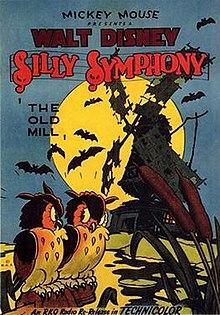
Back The Old Mill Catalan The Old Mill CEB Den gamle mølle Danish Die alte Mühle German The Old Mill DIQ The Old Mill Spanish آسیاب کهنه (فیلم ۱۹۳۷) Persian Le Vieux Moulin French The Old Mill Galician Հին ջրաղաց (մուլտֆիլմ) Armenian
| The Old Mill | |
|---|---|
 Poster for The Old Mill | |
| Directed by | Wilfred Jackson |
| Written by | Dick Huemer |
| Produced by | Walt Disney |
| Music by | Leigh Harline |
| Animation by | |
| Color process | Technicolor |
Production company | |
| Distributed by | RKO Radio Pictures |
Release date |
|
Running time | 9 minutes |
| Country | United States |
| Language | English |
The Old Mill is a Silly Symphonies cartoon produced by Walt Disney Productions, directed by Wilfred Jackson, scored by Leigh Harline, and released theatrically to theatres by RKO Radio Pictures on November 5, 1937.[1] The film depicts the natural community of animals populating an old abandoned windmill in the country, and how they deal with a severe summer thunderstorm that nearly destroys their habitat. It incorporates the song "One Day When We Were Young" from Johann Strauss II's operetta The Gypsy Baron.
The Old Mill was the first Silly Symphony cartoon to be released by RKO and was added a new Silly Symphony logo, some new titles, and a burlap background which was used for several other Disney theatrical cartoon series like Donald Duck, Goofy, Mickey Mouse, and Pluto the Pup.
Like many of the later Silly Symphony shorts, The Old Mill was a testing ground for advanced animation techniques. Marking the first use of Disney's multiplane camera, the film also incorporates realistic depictions of animal behavior, complex lighting and color effects, depictions of wind, rain, lightning, ripples, splashes and reflections, three-dimensional rotation of detailed objects, and the use of timing to produce specific dramatic and emotional effects. All of the lessons learned from making The Old Mill would subsequently be incorporated into Disney's feature-length animated films, such as Snow White and the Seven Dwarfs (1937), which was released a month later, as well as Pinocchio (1940), Fantasia (1940) and Bambi (1942).[2]
In 2015, The Old Mill became the second Silly Symphonies short (after Three Little Pigs) to be selected by the United States Library of Congress for preservation in the National Film Registry as being "culturally, historically, or aesthetically significant".[3]
- ^ Merritt, Russell; Kaufman, J. B. (2016). Walt Disney's Silly Symphonies: A Companion to the Classic Cartoon Series (2nd ed.). Glendale, CA: Disney Editions. pp. 192–195. ISBN 978-1-4847-5132-9.
- ^ Thomas, Bob. Walt Disney: An American Original. Simon & Schuster, 1976, p. 134.
- ^ Mike Barnes (December 16, 2015). "'Ghostbusters', 'Top Gun', 'Shawshank' Enter National Film Registry". The Hollywood Reporter. Retrieved December 16, 2015.